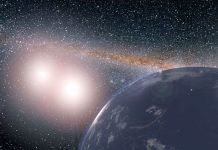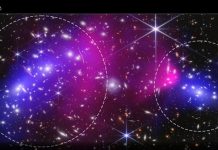
In a dazzling display of cosmic fireworks, astronomers have caught a young star similar to our sun in the act of throwing a massive tantrum, lighting up more than a hundred times its usual brightness in just a few hours.
This star, named HD 283572, is located about 400 light-years away from us and is still in its cosmic childhood, being less than 3 million years old.
What makes this event so special is not just the star’s youthful age but the extreme power of its eruption, offering new insights into the early life of stars like our sun and the impact on planets forming around them.
The discovery was made by a team from the Smithsonian Astrophysical Observatory, using a special set of telescopes in Hawaii known as the Submillimeter Array (SMA).
These telescopes are tuned to detect a kind of light that’s invisible to our eyes, helping scientists study the universe in unique ways.
Originally, the researchers were on the lookout for the faint glow from dust clouds around young stars, where baby planets are beginning to take shape. Instead, they stumbled upon the star HD 283572 throwing a spectacular flare, something they hadn’t anticipated finding.
Star flares are like giant explosions that make the star suddenly much brighter. They happen when a star’s magnetic field, which can get twisted up like a coiled spring, suddenly snaps and releases a huge amount of energy.
Catching these flares, especially at the wavelengths the SMA looks at, is quite rare. The team had been watching HD 283572 for months without seeing anything unusual.
Then, out of the blue, they witnessed this immense flare, making it clear how unpredictable and powerful these young stars can be.
This particular flare was so strong that, in terms of energy, it was like setting off all of Earth’s nuclear bombs in a fraction of a second, and then doing that over and over for nearly half a day.
The energy released was a million times more than any similar flare seen on our sun’s closest neighbors. This shows that even young stars that will eventually look a lot like our sun can have a very tumultuous youth.
The implications for any planets forming around HD 283572 are pretty stark. A flare of this magnitude could seriously harm the development of a planet’s atmosphere, or even strip it away entirely if the planet already had one.
It’s a harsh reminder of the violent conditions that can exist in the regions where new planets are born.
The reason behind this massive flare is still a mystery. It could have been caused by the star’s interaction with an unseen companion star or planet, or maybe it was due to activity on the star’s surface, like sunspots. Whatever the cause, it highlights the dramatic events young stars can go through.
The team is now working to gather more data on HD 283572 and other young stars like it, hoping to better understand how often these flares happen and what impact they might have on the birth of new planets.
By studying these cosmic fireworks, scientists are piecing together the story of our own solar system’s beginnings and the conditions that might exist around other stars where new worlds are taking shape.
The study was published in The Astrophysical Journal Letters.



